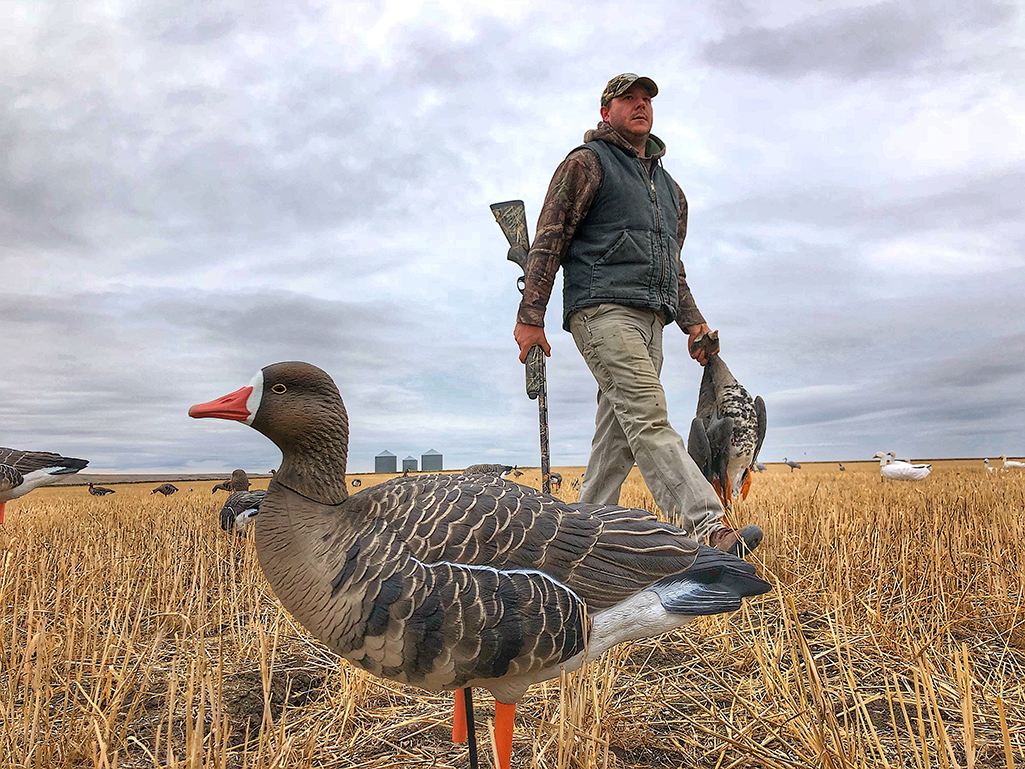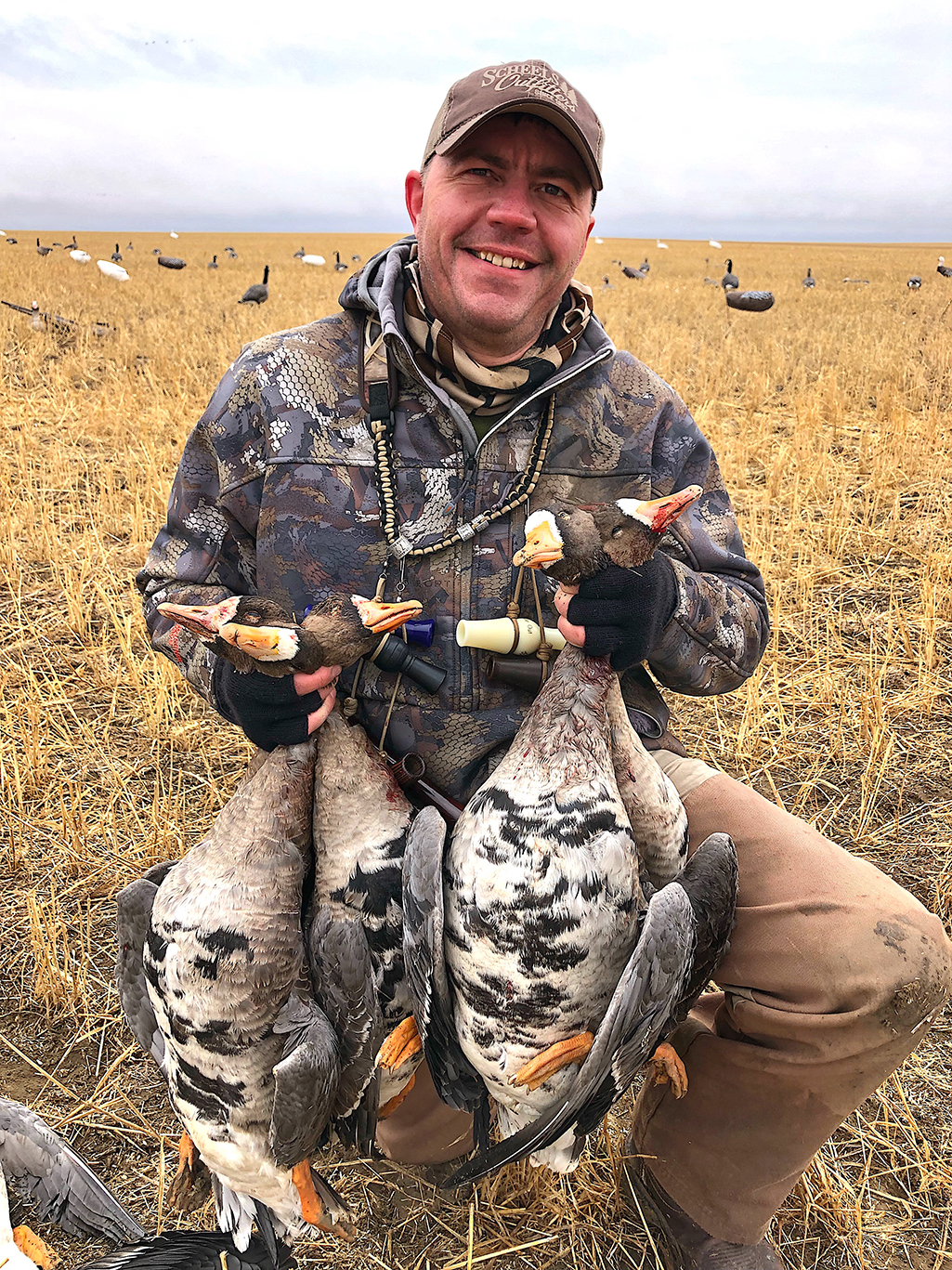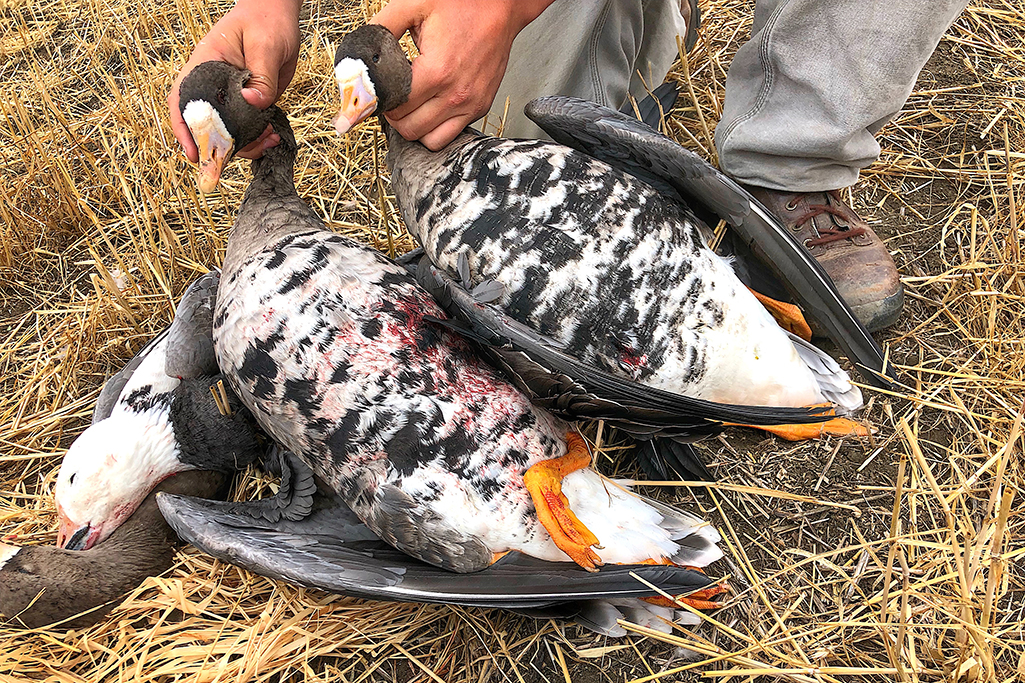Geese on the Saskatchewan Prairies
The prairies of Saskatchewan have a mystique for waterfowl hunters. Big, wide open country where there seems to be an endless amount of birds and not very many hunters. For many migrating geese and ducks, these endless wheat fields are the first encounter with decoy spreads and hunters each fall. Hunters can target or witness a variety of birds; snow geese, blue geese, white-fronted geese (specks or speckle belly geese), several subspecies of Canada geese, cacklers and sand hill cranes, along with puddle ducks like mallards, widgeon and pintails.

Staggering numbers of snow geese, blue geese and ross geese migrate through the prairies of Saskatchewan. Outfitter and guide, Casey Rempel admires a beautiful mature blue goose which is a color phase common in the mid-continent lesser snow goose population.
When you hit the migration right, the volume of geese can be staggering. Flocks of feeding snow geese cover entire sections of land. There have been times where we could see strings of geese moving in every direction around us. The birds typically roost on water, small lakes or in some cases reservoirs. The birds then move out into the fields to feed. Many of the fields are enormous, consisting of crops that include: wheat, barley, lentils and field peas.

Waterfowl hunting in Saskatchewan often occurs in the harvested wheat, barley, lentil and pea fields over large spreads of goose decoys.
Besides the allure of so many birds that haven’t seen very many decoy spreads, the other romance of the Saskatchewan prairies is the feeling of traveling back in time. The people are friendly. Small town Canada at its very best. Many of the farmers are accommodating and graciously open their doors to strangers. Dare I say that this isolated corner of the world might be one of the very best places left to knock on a door and get access to hunt.
We made the journey to Saskatchewan on a mission to hunt white-fronted geese or “specks” as they are often referred. We hunted an area north of Swift Current near the small community of Kyle with Galloway Bay Outfitters owned by Casey Rempel and his wife Alaina. For many hunters particularly in the Midwest, specks are a somewhat exotic bird.

For many Midwest hunters, harvesting a mature white-fronted goose is a coveted experience.
These birds nest near the Arctic Circle and are circumpolar in their breeding distribution. The population that migrates down the Pacific and Central Flyways nest in the subarctic of Alaska and the Northwest Territories. Many of these birds migrate through eastern Alberta and western Saskatchewan. A few birds trickle through eastern Montana and western North Dakota but they seemingly skip across the northern tier of the US prairies before concentrating again in Kansas. Ultimately, many of these geese winter in Texas and Louisiana. Needless to say, we don’t see a lot of these beautiful birds living in the Midwest unless we go north or south. Interestingly, we see piles of specks through the Dakotas during the spring snow goose conservation season when we obviously can’t hunt them. These birds seemingly take a different migration route in the spring versus the fall.

Arguably one of the most beautiful waterfowl species in North America, this fascinating bird nests near the Arctic Circle and travels the Central and Pacific Flyways.
Of all geese, specks are arguably one of the best eating birds but their sheer beauty is what makes hunting these birds so intriguing. With a chocolate brown back and neck, the birds have a bright white ring on their face next to a bill that is the color of a carrot. Bright orange feet compliment a light chest that is covered in dark grey bars. If there was ever a bird that was designed to make a taxidermist’s eyes light up, an adult speck would have to be that bird.
We arrived to our Saskatchewan camp in the dark and met Casey and his wife Alaina. I liked Casey as soon as I met him. A former college hockey player who also has a passion for waterfowl hunting. Casey is cut out of the quiet, hard-working and no nonsense mold that seems to define a lot of people from this area. His wife Alaina is outgoing and friendly, the organization behind the chaos of guiding hunters day after day. I soon learned that the operation was a family affair with Alaina’s father and sister also helping in different capacities while Casey’s mom baked and made desserts for the hunters. After getting our licenses, we settled into a comfortable farm house smack dab in the middle of Saskatchewan prairie and wheat fields. Lake Diefenbaker and the Saskatchewan River could be faintly seen on the far horizon. From the farm house, we never had to travel very far to hunt. In fact one afternoon, we hunted sand hill cranes about a half mile from where we slept.

Sandhill cranes are a challenging bird to hunt. Often hunted using decoys much like hunting ducks or geese, these birds are incredible table fare.
There were good numbers of snow geese moving into the area but the number of specks we saw was numbing. There were specks seemingly everywhere. A true challenge to decide where to hunt because there were so many fields that had birds. We set up about six dozen full body speck decoys complimented with about the same number of full body Canada goose decoys. Upwind of the dark geese, we typically put out a few hundred snow and blue goose wind socks. The specks came out in small groups, their laughing call piercing the cool air. Most of the birds were hugging the ground, approaching the spread from heights that might have only been ten to forty yards high. Snow geese added to each morning. A tundra trifecta of geese with bags that consisted of ross geese, snow and blue geese along with specks.
After each morning’s hunt, we settled back at the farm house for a large lunch. The farm house brought you back in time. Guessing that the home was probably at least seventy years old, the house now served hunters. As we sat around the table, I couldn’t help but think about some of the earlier ranchers and farmers that raised families on this stark open country. Small by today’s standards, I imagined a housewife working tirelessly in this same kitchen providing for a family while a seasoned rancher worked long hours each day out in the barn or on the range. Every new season bringing new responsibilities and challenges.

Limits of specks makes for smiling hunters.
The food was incredible. Home cooked meals you won’t find at a restaurant. Great conversation and the kindest hosts you could ever hope for. The kind of hospitality that makes you homesick when you leave.
After a heavy lunch, we spent some time driving the backroads with Casey as he scouted for the next day. Growing up as a child in the area, he seemingly knew every farmer and had access to an amazing amount of land.
We filmed three days with Galloway Bay Outfitters for our upcoming season of Passion for the Hunt Television that airs on Fox Sports North. We ended up with more bird footage than we could ever put in one show. Spending time hunting specks, snow geese and sand hill cranes, we hope to do the entire hunt, the entire experience justice with video. This region of Saskatchewan truly is a special place if you have a passion for waterfowl hunting. A combination of great hunting, incredible bird numbers, friendly people, home cooked meals and a ruggedly beautiful landscape combines to make this destination a place we someday hope to return to.
More information on Galloway Bay Outfitters can be found online at www.gallowaybayoutfitters.com.

